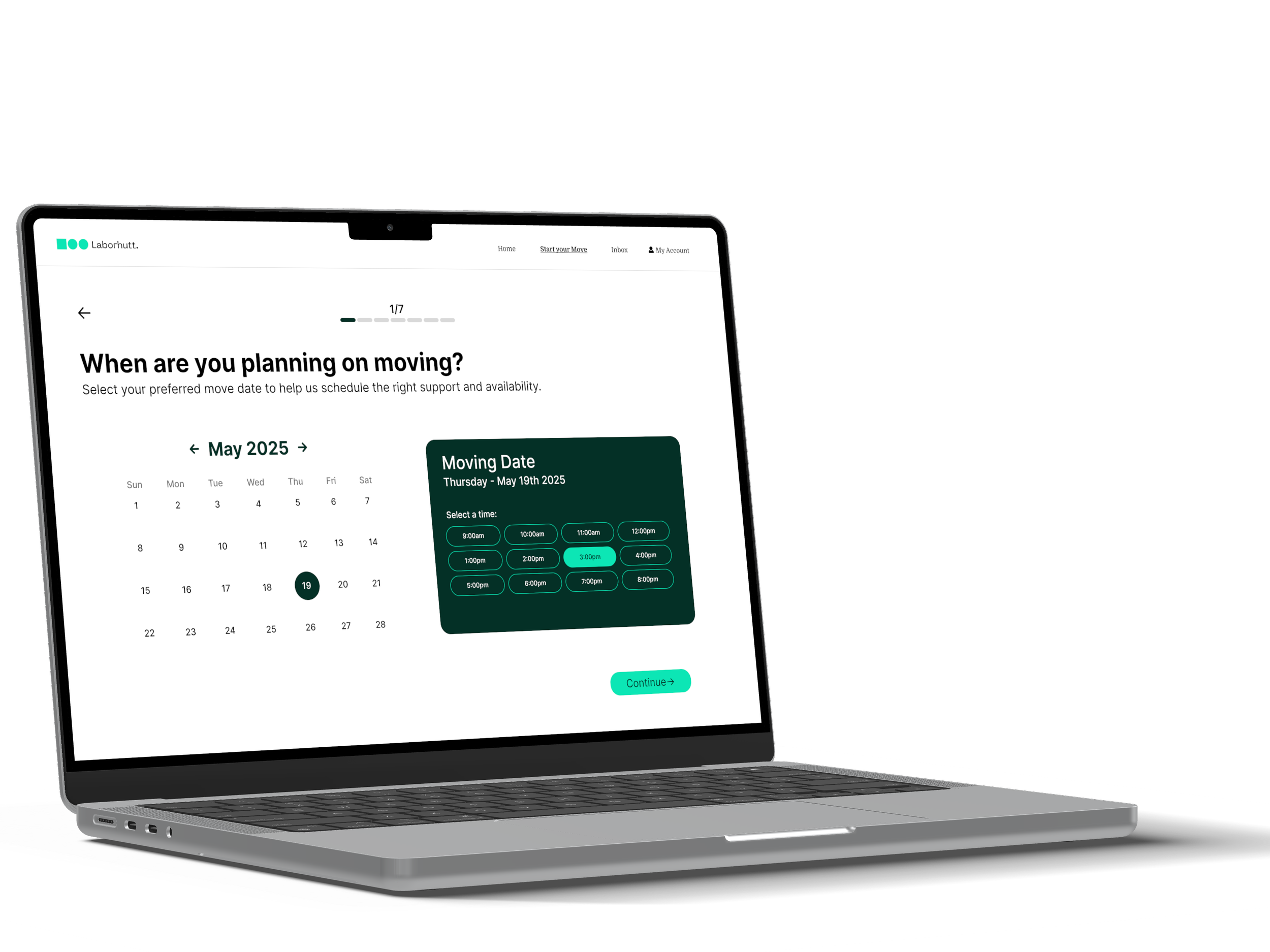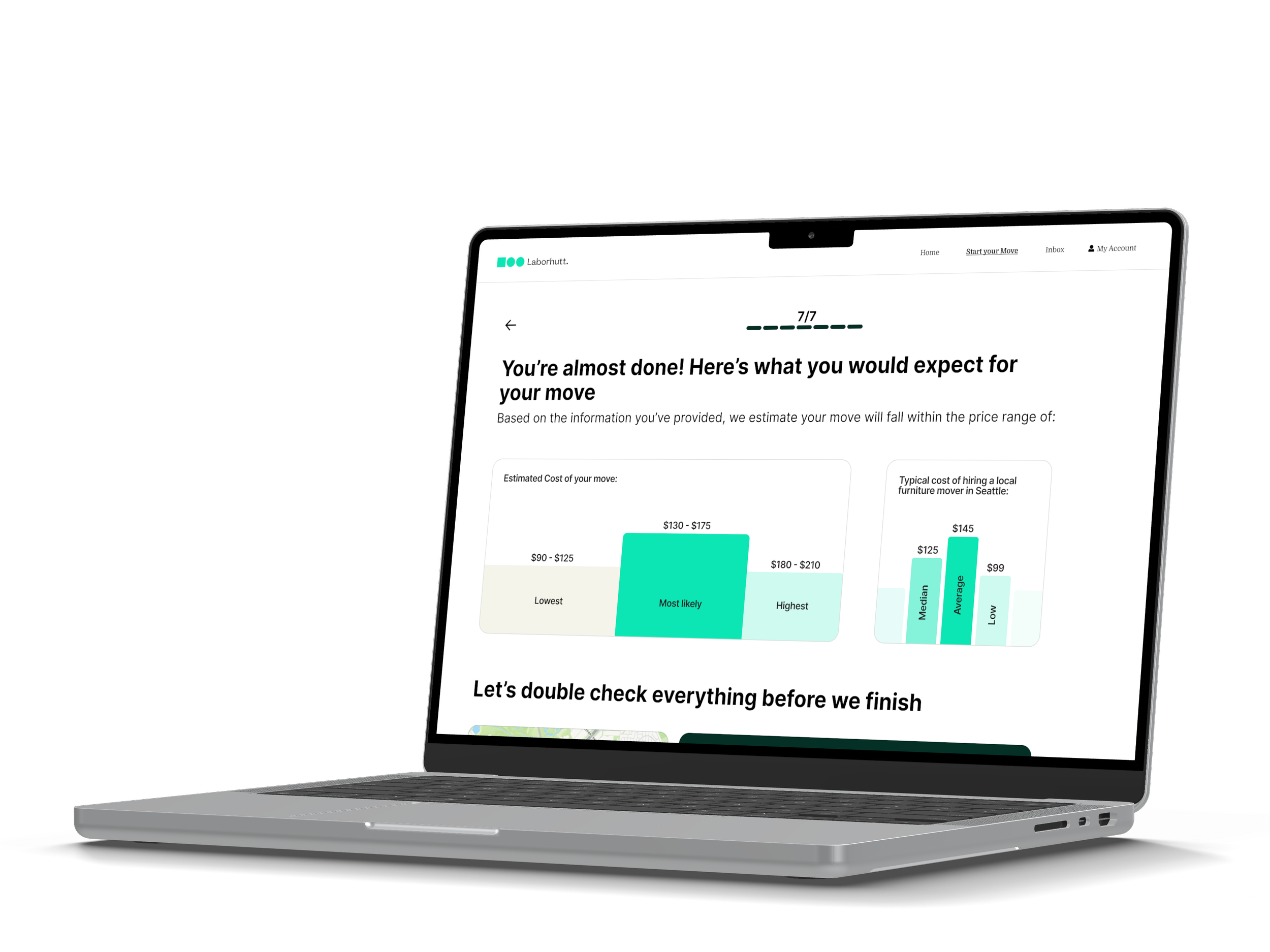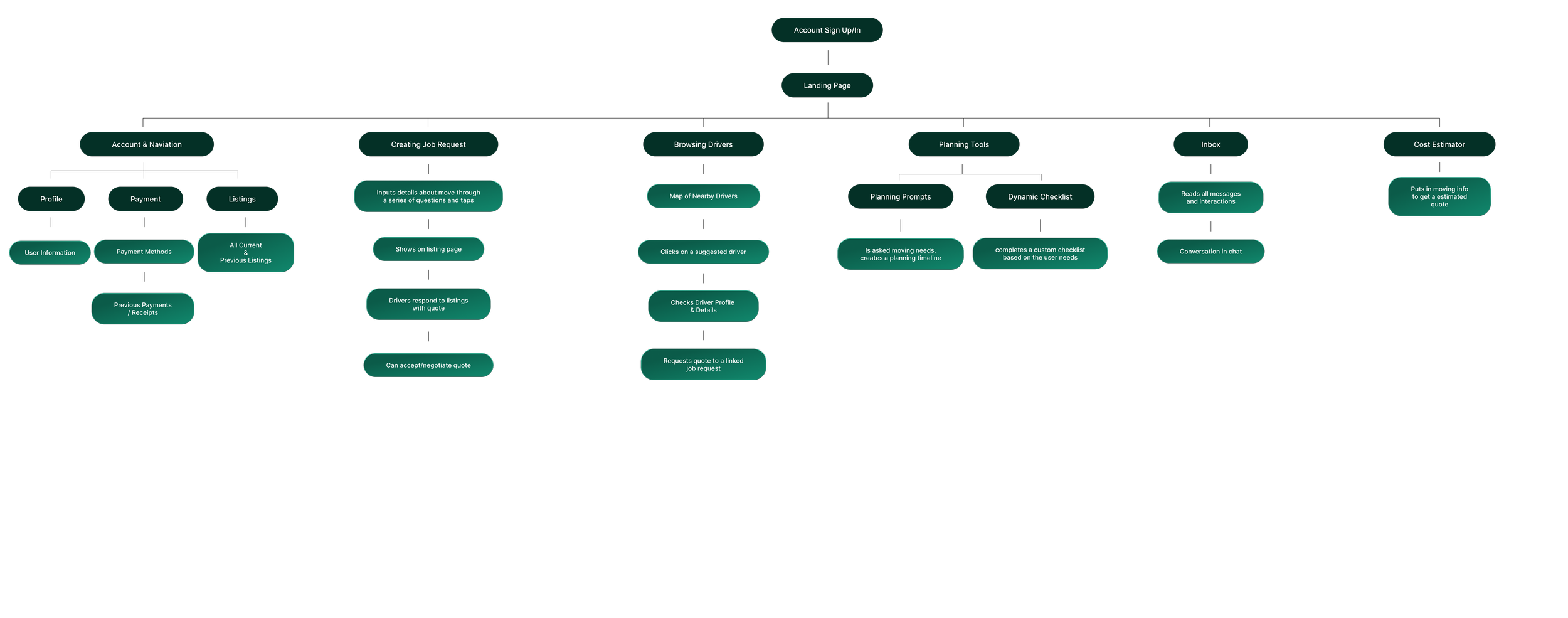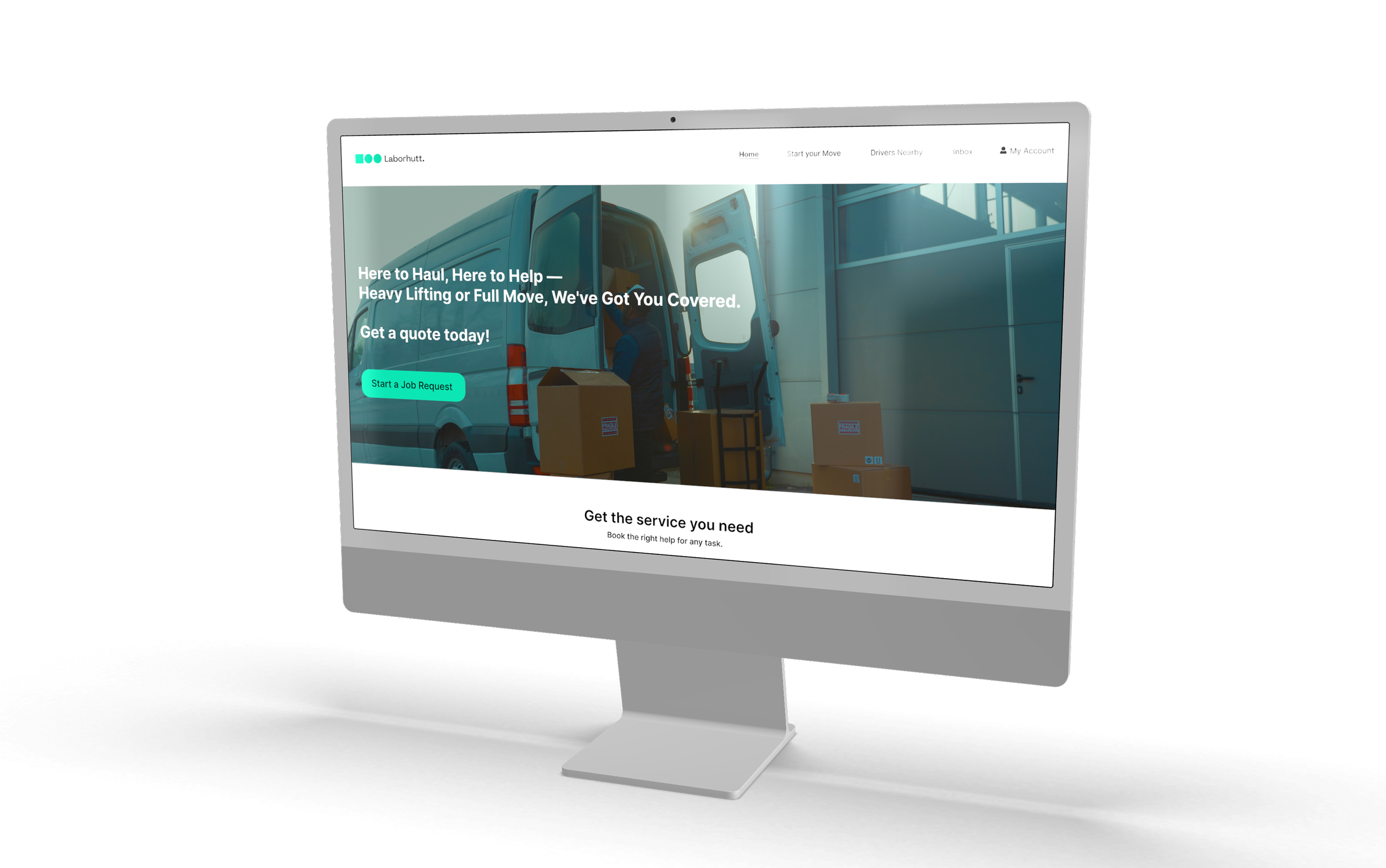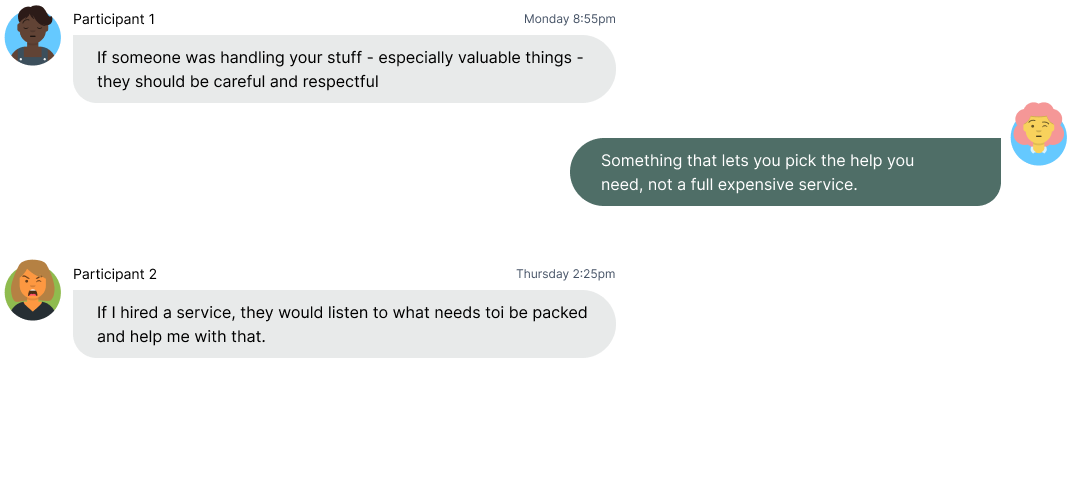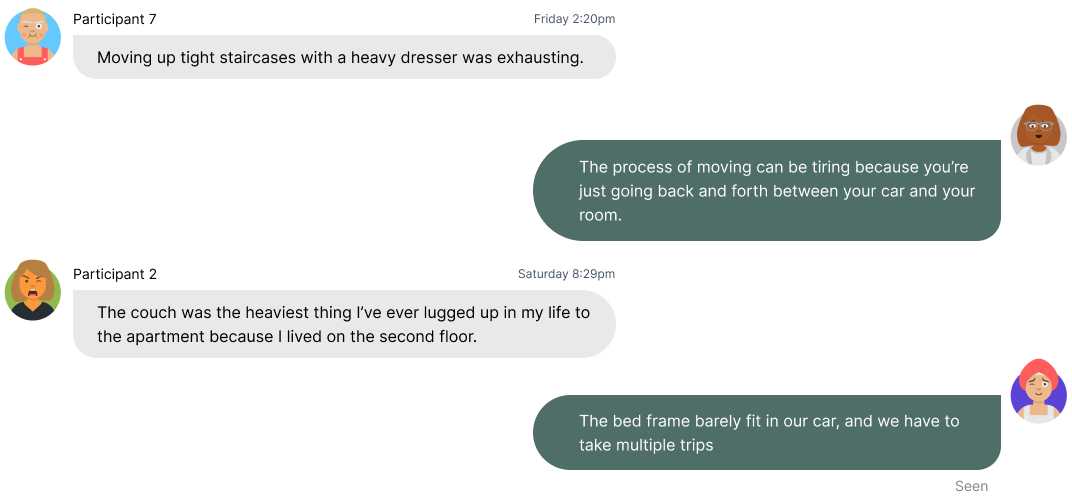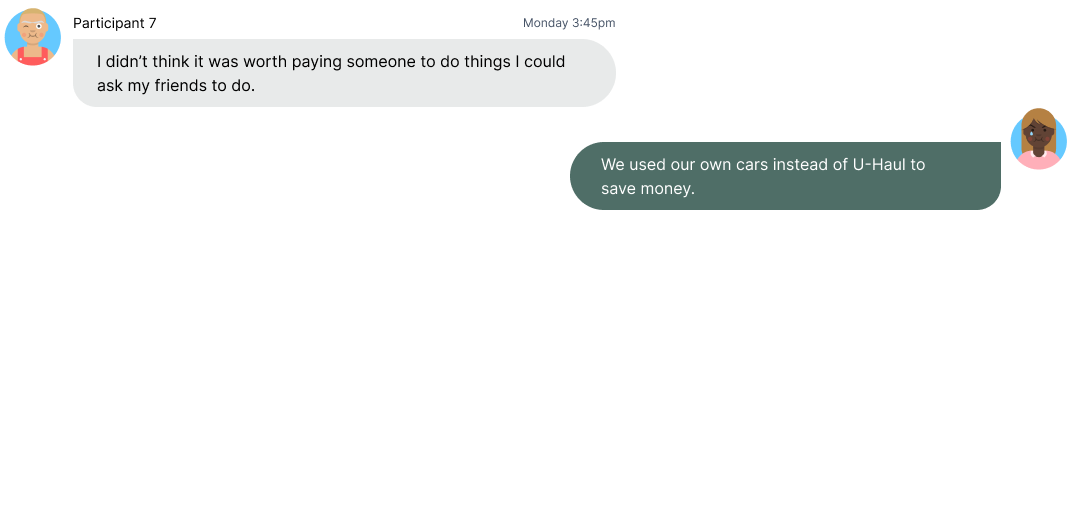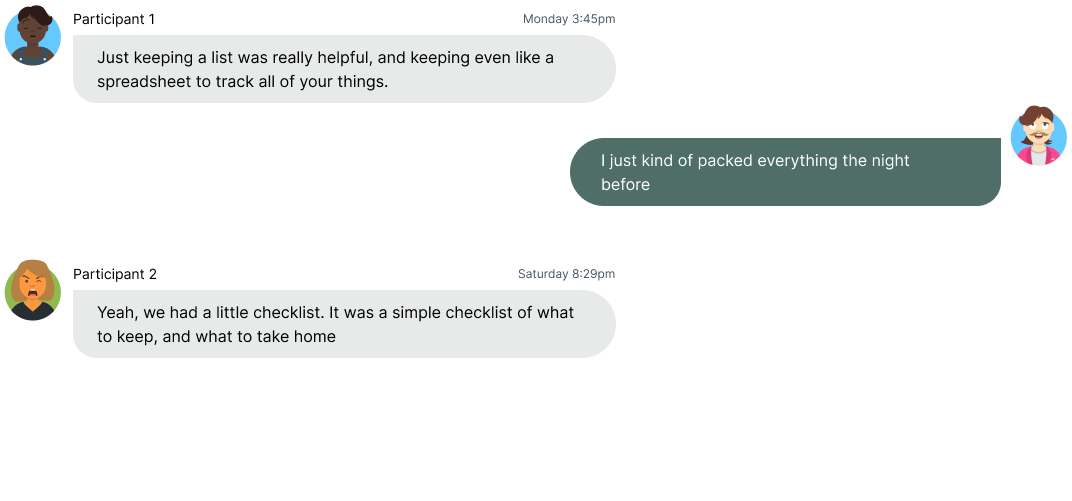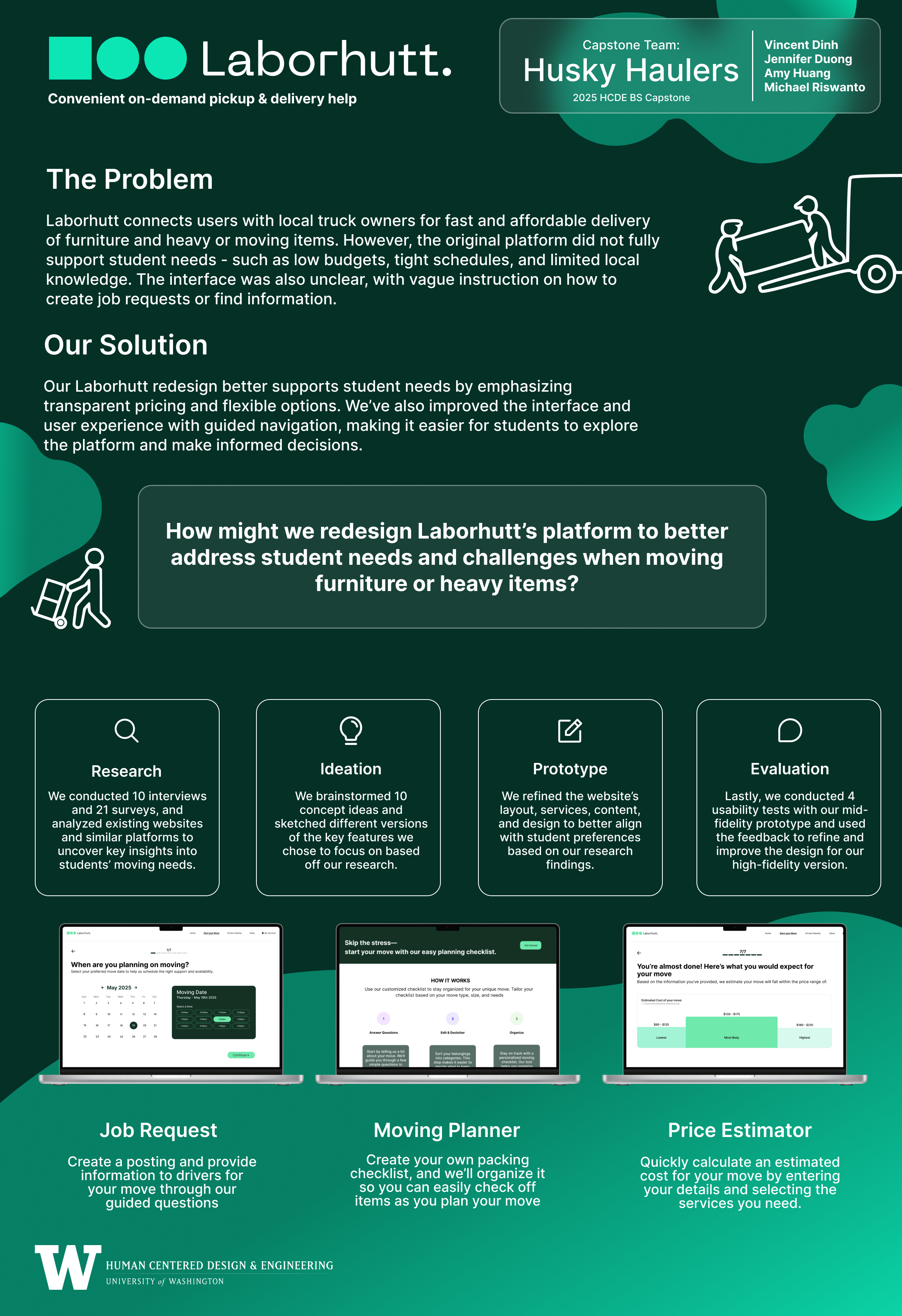Laborhutt
Need a hand? Laborhutt is a community-powered moving service connecting locals with nearby drivers for quick and affordable help with heavy items.
Timeline
January 2025 - June 2025
Project Manager
UX Designer
UX Researcher
Roles
Project Management
UI/Visual Design
Usability Testing & Iteration
User Interviews & Surveys
Usability Testing & Analysis
Responsibilities
Professionalism, & Transparency
Students want moving services that are simple, transparent, and professional—easy to use, affordable, and respectful of their time and belongings.
The top features students wanted in a moving service were transparent pricing, reliable helper reviews, & the flexibility to book last-minute when needed.Research - User Journey
How would Laborhutt benefit Eric?
To better illustrate how Eric’s experience before and during the moving process, we mapped out a user journey that highlights his thoughts, actions, and emotions at each stage of the process. This journey represents the key moments and challenges students like Eric may face, providing insight into opportunities for design improvements.
Research - User Flow
What would this process look like?
To properly demonstrate how Laborhutt operates in this space, the next step was to create a user flow with information architecture. Giving opportunities to explore different pathways that fit the different needs of students. This process allowed Laborhutt to address all the goals, needs, and struggles that students faced when moving, creating a stress-free and intuitive experience.
Ideation - Concepts Brainstorm
What was added to help students?
Alongside our CEO, Jordan, our team engaged in a brainstorming session to explore ways Laborhutt could better meet the needs of students. We examined existing features, like the cost estimator, and identified gaps such as limited transparency and unclear alignment with student priorities. This led us to improve and ideate on new concepts that could make the platform feel more reliable, student-friendly, and intuitive.
Ideation - Initial Sketches
What changes did you start to make in the design?
To kick off the design phase, our team focused on translating research insights into actionable design directions. We used collaborative whiteboarding and sketching sessions to map out core features, prioritize user needs, and explore multiple interface approaches. These early iterations allowed us to test assumptions, align on goals, and set the foundation for more refined prototypes.
Design - Low Fidelity Prototypes
How did your design look like early on?
Building on our concept ideas, we worked to improve the booking process by creating a simpler, more guided flow. Our lo-fi designs emphasized clear navigation and intuitive steps, aiming to reduce stress for students while making the moving process feel more organized and manageable.
Design - Mid-Fidelity Prototypes
Where did you guys take this initial design?
With our foundation in place, our team continued to build on these ideas by adding depth and detail to our design, including color, descriptions, and relevant imagery. Emulating our vision in helping students during their moving process to be more organized and manageable by polishing our work.
Mid-Fidelity Prototypes
Home Page & Navigation
The homepage now incorporates color, guided directions, and structured layouts to reduce overwhelmingness and to provide students with a clearer starting point in the moving process.
Navigation was streamlined with simplified menus and improved organization, allowing users to move between pages more intuitively and quickly access the information they need.
Mid-Fidelity Prototypes
Additional Enhancements
Additional enhancements included implementing a chat inbox that allows users and drivers to communicate or negotiate directly, making coordination smoother during the moving process.
We also added a time and date selection feature, which had been overlooked in the lo-fi stage, to ensure students could better plan and schedule their moves with confidence.
Design - Usability Testing
How did users feel about your designs?
With our mid-fi prototypes complete, our team conducted recruited 4 users to conduct usability testing to help us find any additional pain points and refine the overall experience.
The feedback we got from our users was invaluable. By incorporating these insights, we refined our prototype into a more supportive and organized experience, better reflecting the needs of students
Mid-Fidelity Prototypes
Cost Estimate & Transparency
The cost estimator was visually updated to align with the overall design language, while also improving clarity in how users interpret pricing details based on their inputs.
These refinements not only made the feature feel more cohesive with the platform but also increased transparency, helping students better understand the value of the service.
Background
What’s Laborhutt?
Laborhutt is a community-powered moving service that connects people who need help transporting heavy items with nearby drivers who have the right vehicles.
By leveraging local networks, the platform offers a cost-effective alternative to traditional movers or rental trucks, which builds trust and support within local communities
Operating in the problem space of designing accessible services for students, Laborhutt addresses the common challenges students face when transitioning housing with limited budgets, lack of access to large vehicles, and the stress of coordinating moves.
How might we redesign Laborhutt’s platform to better address student needs and challenges when moving furniture or heavy items?
Research - Competitor Analysis
What are other platforms doing that we aren’t?
To better understand the landscape, we conducted a competitive analysis of platforms like Bellhop, TaskRabbit, Dolly, and Collegeboxes. Helping us evaluate their audiences, strengths, and weaknesses, and identify gaps and opportunities where Laborhutt could uniquely serve college students and local movers.
Research - User Interviews & Surveys
Planning Tools
Students showed a clear split between planners who used notes or lists and those who packed at the last minute. Several non-planners noted that using a list or spreadsheet could have made their move easier.
In the survey, most students said they start planning 1–2 weeks in advance, but 33% wait until the last minuteResearch - User Personas
So who is our target user?
To identify our ideal user who would most benefit from moving needs, our team compiled all the common goals, needs, and frustrations that our participants faced into a user persona that represents those experiences.
Strengths
Weaknesses
✅ Transparent Pricing
✅ Flexible Service Options
✅ Trust Building Features
❌ Limited Student Focus
❌ Higher Costs
❌ Stressful
We wanted to focus our design that caters to students and their needs specifically, balancing a stress-free environment with clear and transparent pricing models
How do students feel about moving?
To better understand their needs, we connected with local students within the greater Seattle region to identify and capture these experiences through interviews and surveys.
Logistical & Physical Challenges
Many students described the physical process of moving as draining and difficult. Especially when it involved stairs, tight hallways, limited parking, or multiple trips due to smaller cars
Connections & Reliance
Most students rely on family or friends to help with moving if they have access to them. While it is helpful, this arrangement often requires schedule coordination, compromises, and physical strains upon family members.
Over 65% of survey respondents cited “physical effort or heavy lifting” and “lack of transportation” as top challenges.87% of survey respondents reported relying on friends or family during their last moveOver 70% of survey respondents selected “affordability” as their most valued factor in choosing a moving service.Budget-Consciousness
Even when students were aware of moving services, most chose not to use them due to cost concerns or assumptions that they were unaffordable.
Introducing:
Laborhutt
Final Design
Navigation & Job Request Flow:
Our prototype highlights a smoother navigation flow starting right from the home page, making it easier to get around. It also introduces a more guided approach for users when filling out a job request, helping the process feel clearer and less overwhelming.
Customized Checklist
Many students often rely on cluttered checklists to plan their moves, adding more stress than structure. Our prototype introduces a simpler, catered checklist designed to keep everything organized and manageable for the big day.
Design Takeaway - Reflection
What was your rationale in your final design?
Our final design focused on refining the key challenges uncovered during mid-fi user testing, ensuring the platform not only resolved usability issues but also felt familiar and welcoming to students.
Rather than pursuing something entirely groundbreaking, we aimed to stay true to Laborhutt’s purpose — creating a professional, approachable, and easy-to-navigate experience that reflects how students naturally plan their moves. By prioritizing clarity, comfort, and usability, our design empowers students to move with confidence through an interface that feels intuitive, trustworthy, and genuinely supportive during a typically stressful process.
Design Takeaway - Impact
What impact did your final designs have on students?
After completing our final designs, our team presented to stakeholders at our capstone showcase with judges and fellow students.
We created a poster that highlighted the challenges students face, our proposed solutions, and key insights gained throughout our process.
Our design was well received; judges appreciated the clear, supportive flow of the experience, while students described it as a more calming and approachable platform in a polar environment.
Many praised the addition of transparent pricing and customizable checklists, noting that these features made the service feel more trustworthy, organized, and aligned with their needs. Ultimately, transforming Laborhutt into a solution that genuinely empowers students to move with confidence.
My takeaways.
This six-month journey with our project sponsor, Laborhutt, was a challenging, but gratifiying journey in human-centered design. Teaching me how to manage ambiguity and take initiative with skills that challenged and strengthened my ability to lead and adapt under uncertainty.
Throughout the project, I took an active role in both research and design, contributing to user research while leading the final design direction. Acting as the design lead, I helped guide our team toward meaningful solutions and consistency across our deliverables. We faced many hurdles, like skill gaps and burnout, but through strong communication and collaboration, we managed to stay aligned and produce a final product we were proud of.
This experience reminded me of why I’m passionate about human-centered design. Creating solutions that are practical, empathetic, and rooted in real needs. The capstone not only refined my technical and collaborative skills but also gave me a glimpse into the impact that thoughtful design can make in the real world. As I move forward, I carry these lessons into every project I take on, continuing to grow as both a designer and teammate.
Final Reflection - Personal Takeaway
Thank you to my fellow teammates
